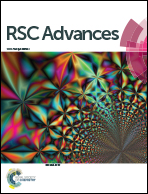Cooperative self-healing performance of shape memory polyurethane and Alodine-containing microcapsules
Abstract
In this study, a method to prepare self-healing coatings by incorporating Alodine-containing microcapsules as fillers in Shape Memory Polyurethane (SMPU) was presented. Toluene diisocyanate (TDI) prepolymer was prepared for the microcapsule shells, while a healing agent (Alodine 5200) was selected for the core. SMPU with polyethylene glycol (PEG) as the soft segments and isophorone diisocyanate (IPDI) and 2,2-hydroxymethyl butyric acid (DMBA) as the hard segments were synthesized as main film-formers. A set of techniques including Fourier transform infrared spectroscopy (FTIR), thermogravimetric analysis (TGA), electrochemical impedance spectroscopy (EIS), Scanning Kelvin Probe (SKP), and optical microscopy were used to completely characterize their self-healing performance on Al 7B04 T74 aluminum alloy surfaces. The study on the self-healing mechanism indicated that the self-healing process can be divided into two stages, and there was enormous potential for repairing large cracks with this technique.



 Please wait while we load your content...
Please wait while we load your content...